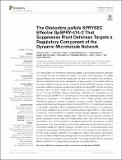Files in this item
The Globodera pallida SPRYSEC effector GpSPRY-414-2 that suppresses plant defenses targets a regulatory component of the dynamic microtubule network
Item metadata
| dc.contributor.author | Mei, Yuanyuan | |
| dc.contributor.author | Wright, Kathryn M. | |
| dc.contributor.author | Haegeman, Annelies | |
| dc.contributor.author | Bauters, Lander | |
| dc.contributor.author | Diaz-Granados, Amalia | |
| dc.contributor.author | Goverse, Aska | |
| dc.contributor.author | Gheysen, Godelieve | |
| dc.contributor.author | Jones, John T. | |
| dc.contributor.author | Mantelin, Sophie | |
| dc.date.accessioned | 2018-07-13T08:30:05Z | |
| dc.date.available | 2018-07-13T08:30:05Z | |
| dc.date.issued | 2018-07-12 | |
| dc.identifier | 254733157 | |
| dc.identifier | 598c16b2-6601-482a-a212-dd4b8559ba6c | |
| dc.identifier | 85050804151 | |
| dc.identifier | 000438360700001 | |
| dc.identifier.citation | Mei , Y , Wright , K M , Haegeman , A , Bauters , L , Diaz-Granados , A , Goverse , A , Gheysen , G , Jones , J T & Mantelin , S 2018 , ' The Globodera pallida SPRYSEC effector Gp SPRY-414-2 that suppresses plant defenses targets a regulatory component of the dynamic microtubule network ' , Frontiers in Plant Science , vol. 9 , 1019 . https://doi.org/10.3389/fpls.2018.01019 | en |
| dc.identifier.issn | 1664-462X | |
| dc.identifier.other | RIS: urn:164B977C652B65FF2FE8B5DF8D7F0A69 | |
| dc.identifier.uri | https://hdl.handle.net/10023/15341 | |
| dc.description | The James Hutton Institute receives funding from the Scottish Government Rural and Environment Science and Analytical Services division. YM was funded through a BOF Ph.D. scholarship (Bijzonder Onderzoeksfonds, Ghent University). This collaboration was supported by an International Exchanges Award (IE110776) from the Royal Society and benefited from interactions funded by COST Action FA1208. | en |
| dc.description.abstract | The white potato cyst nematode, Globodera pallida, is an obligate biotrophic pathogen of a limited number of Solanaceous plants. Like other plant pathogens, G. pallida deploys effectors into its host that manipulate the plant to the benefit of the nematode. Genome analysis has led to the identification of large numbers of candidate effectors from this nematode, including the cyst nematode-specific SPRYSEC proteins. These are a secreted subset of a hugely expanded gene family encoding SPRY domain-containing proteins, many of which remain to be characterized. We investigated the function of one of these SPRYSEC effector candidates, GpSPRY-414-2. Expression of the gene encoding GpSPRY-414-2 is restricted to the dorsal pharyngeal gland cell and reducing its expression in G. pallida infective second stage juveniles using RNA interference causes a reduction in parasitic success on potato. Transient expression assays in Nicotiana benthamiana indicated that GpSPRY-414-2 disrupts plant defenses. It specifically suppresses effector-triggered immunity (ETI) induced by co-expression of the Gpa2 resistance gene and its cognate avirulence factor RBP-1. It also causes a reduction in the production of reactive oxygen species triggered by exposure of plants to the bacterial flagellin epitope flg22. Yeast two-hybrid screening identified a potato cytoplasmic linker protein (CLIP)-associated protein (StCLASP) as a host target of GpSPRY-414-2. The two proteins co-localize in planta at the microtubules. CLASPs are members of a conserved class of microtubule-associated proteins that contribute to microtubule stability and growth. However, disruption of the microtubule network does not prevent suppression of ETI by GpSPRY-414-2 nor the interaction of the effector with its host target. Besides, GpSPRY-414-2 stabilizes its target while effector dimerization and the formation of high molecular weight protein complexes including GpSPRY-414-2 are prompted in the presence of the StCLASP. These data indicate that the nematode effector GpSPRY-414-2 targets the microtubules to facilitate infection. | |
| dc.format.extent | 16 | |
| dc.format.extent | 3297709 | |
| dc.language.iso | eng | |
| dc.relation.ispartof | Frontiers in Plant Science | en |
| dc.subject | CLASP | en |
| dc.subject | Defense suppression | en |
| dc.subject | Effector | en |
| dc.subject | Microtubules | en |
| dc.subject | Nematode | en |
| dc.subject | Potato | en |
| dc.subject | SPRYSEC | en |
| dc.subject | QH301 Biology | en |
| dc.subject | DAS | en |
| dc.subject.lcc | QH301 | en |
| dc.title | The Globodera pallida SPRYSEC effector GpSPRY-414-2 that suppresses plant defenses targets a regulatory component of the dynamic microtubule network | en |
| dc.type | Journal article | en |
| dc.contributor.institution | University of St Andrews. Biomedical Sciences Research Complex | en |
| dc.contributor.institution | University of St Andrews. School of Biology | en |
| dc.identifier.doi | 10.3389/fpls.2018.01019 | |
| dc.description.status | Peer reviewed | en |
This item appears in the following Collection(s)
Items in the St Andrews Research Repository are protected by copyright, with all rights reserved, unless otherwise indicated.

